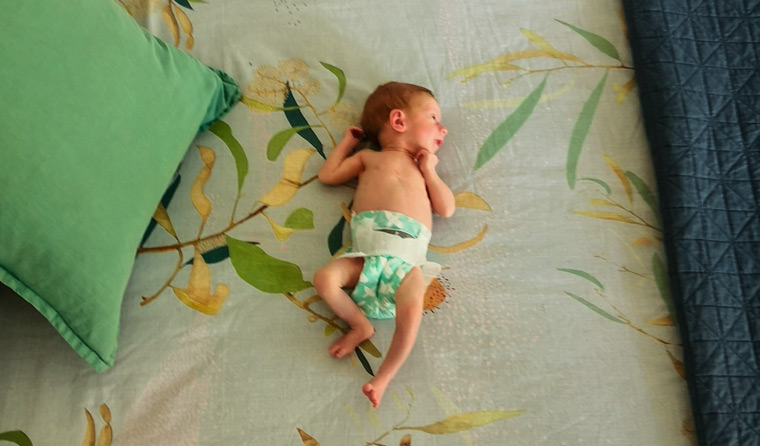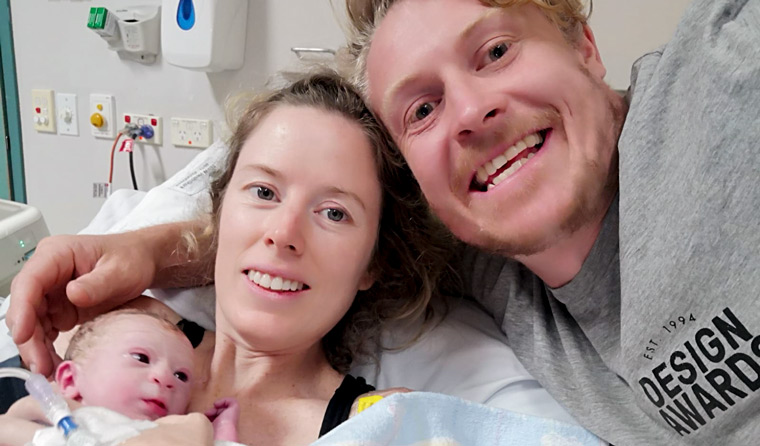Feature
A registrar’s daughter nearly died in utero – was it bushfire smoke?
After months of bushfire smoke, this uneventful pregnancy almost turned fatal.
 For the first three weeks of Saga’s life, her mother had to express every three hours and take the milk to the hospital.
For the first three weeks of Saga’s life, her mother had to express every three hours and take the milk to the hospital.
The baby girl arrived very early – and significantly underweight at just 1.8 kg.
But Saga was alive.
She had made it through a difficult gestation, affected by dwindling placental blood flow, while her parents worried themselves sick.
But it wasn’t until the midwife scrutinised the placenta that Dr Roly Stokes began to wonder why his daughter's birth had been such a close-run thing.
The Wollongong general practice registrar and his partner Amber had just lived through months of dense bushfire smoke during Australia’s Black Summer. Despite their best efforts, the smoke was impossible to avoid.
Now their midwife was asking them why Amber’s placenta looked like one from a lifelong smoker.
Dr Stokes came over to look. It certainly did, though his partner had never smoked a cigarette in her life.
‘[The placenta] was much smaller and really irregular in texture and colour. It was very fragile and lumpy,’ Dr Stokes told newsGP.
The puzzle pieces started to come together.
Saga had been due on 24 January. She came three and a half weeks early – and she was tiny, at only the second percentile for weight.
A scan for an unrelated matter in late December had picked up issues with Saga’s size. A follow-up a week later found further reason for concern: Saga wasn’t growing, the amniotic fluid was reducing and there were issues with placental blood flow.
‘You get the best outcomes with placental failure at 37 weeks. We were at 36.4 weeks, so we thought we should wait to have the best balance of surviving birth versus the risk of stillbirth,’ Dr Stokes said.
But while the science suggested waiting, Dr Stokes and Amber found it all but impossible.
The idea of waiting three days – during which time Saga’s heart might simply stop – was a torment. Soon afterwards, they and their doctors decided they had to risk it.
An induction was booked for New Year’s Day, but Amber’s waters broke overnight.
When the obstetrician said the baby really was coming almost a month early, Amber began trembling uncontrollably.
‘I couldn’t stop her with my hands. The shock of the news was so powerful,’ Dr Stokes said. ‘I’ve never seen someone react so fiercely to an emotional trigger like that.
‘She was pretty much like that for six hours until Saga turned up.’
The late pregnancy and birth were traumatic for the parents.
‘Working as a GP registrar, you see these kinds of things happen to people, but you never think it will happen to you,’ Dr Stokes said. ‘It was eye-opening, humbling, and bloody scary, thinking we had to sit around and wait for Saga to either be stillborn or not.
‘You build a relationship with this unborn baby in different ways – naming her, the anticipation, feeling a kick. It was just terrifying. And the moment she was born healthy was the most relieved I’ve ever been in my life.’

Saga weighed just 1.8 kg when she arrived nearly a month early.
In the aftermath, Dr Stokes read up on the impact of bushfire smoke on pregnancy. What he found was worrying.
The best evidence available to date was a 2019 population study of half a million women in Colorado. That study showed bushfire smoke was linked to pre-term births and low birth weight, and associations with hypertension and gestational diabetes.
Other experts were warning that smoke could disproportionately affect pregnant women – who breathe at an increased rate – and babies, as PM2.5 particles could penetrate the lungs and cause inflammatory damage to the placenta. Not only that, but the smoke could potentially have longer-term consequences.
‘It’s impossible to say Saga’s birth was [directly] affected by the smoke, but you’d be brave to say it wasn’t,’ Dr Stokes said.
For the first three weeks of Saga’s life, Amber had to express every three hours and take the milk to the hospital.
‘It was very demanding – a tremendous effort by her,’ Dr Stokes said.
Saga started eventually gaining weight, sleeping more. And then it rained.
‘When we were in hospital it was the peak of the fires. New Year’s Eve was when Cobargo burned and it was thick with smoke outside,’ Dr Stokes said. ‘So the rain has been a relief for everyone.
‘Saga waking up coincided with the rain.’
For other GPs, Dr Stoke warns that smoke-affected births will still be coming.
‘We need to be very aware of this risk of pre-term babies and smoke-affected births. That’s very important,’ he said. ‘And we need to help guide people to understand when their ill health is a result of climate change.’
As he spoke to colleagues in the hospital, Dr Stokes realised his family’s story was not unique.
Hospital doctors told him there had been more children in the pre-term nursery than usual, while midwives talked about a spate of unusually low birth weights.
During the worst of the fires in January, the Royal Australian College of Obstetricians and Gynaecologists (RANZCOG) warned that prolonged exposure to bushfire smoke could lead to negative outcomes in pregnancies.
‘Exposure to air pollution in pregnancy has been linked to increased rates of pre-term birth, decreased birth weight, hypertensive disorder of pregnancy and gestational diabetes,’ RANZCOG President Dr Vijay Roach warned.
It seems these warnings are now coming to pass.
An experienced midwife in Canberra told newsGP that the smoke seemed to be having a significant impact.
‘There will be a noticeable [health] blip,’ the midwife, who did not want to be named, said. ‘People will ask, “Were you born during the 2020 fires?”
‘We are seeing lots of high maternal blood pressure, lots of smaller-than-expected babies.
‘We suspect this is from smoke. Babies are coming out smaller than you’d expect from the gestation. Some babies are not handling labour very well, which can be a sign of placental dysfunction.’
Poor-quality placentas are also being seen more often, she said.
‘As midwives who look at placentas all the time, we’ve noticed these ones are more friable and gritty. When they come out they should be nice and soft; instead, they’ve got hard white calcified bits all over them.
‘A smoker’s placenta is like that.’
Hobart-based obstetrician and Doctors for the Environment member Dr Kristine Barnden told newsGP that low birth weight and pre-term births are the main expected outcomes from protracted exposure to bushfire smoke.
She said women exposed to smoke during their second trimester are most at risk of pre-term birth, based on the Colorado study.
‘For an individual, the risk isn’t huge,’ she explained. ‘But over a population it’s quite a large number of pre-term births that wouldn’t have happened otherwise.’
Dr Barnden said that even though care of pre-term babies has improved significantly, on a population level, even being born a few weeks early has been linked to an increased risk of several health problems, including hypertension, diabetes, respiratory conditions and minor changes to intellectual performance.

‘It’s impossible to say Saga’s birth was affected by the smoke, but you’d be brave to say it wasn’t,’ GP registrar Dr Roly Stokes said of his infant daughter.
For Dr Stokes, the story isn’t over. Though the fires and smoke have finally ended, the trauma has left him changed.
While he and his family are environmentally minded and had been planning to go off grid on their farm, he had not been actively involved in climate change advocacy.
But that has changed.
The unprecedented fire season – boosted by rising global temperatures – has quite likely hurt Dr Stokes’ infant daughter.
In response, he set up a GoFundMe – not for Saga’s medical needs, but in an attempt to take action on climate change.
He writes:
‘On the first day of this new decade, climate change almost killed my unborn daughter … A nebulous, slow-moving, unseen, human-caused global pathology has unfolded into a tangible, acute, visible, personal impact in the form of my very lucky daughter named Saga. Climate change almost killed my daughter. It will kill other unborn children.’
Log in below to join the conversation.
air pollution bushfires climate change maternal health
newsGP weekly poll
Is it becoming more difficult to access specialist psychiatric support for patients with complex mental presentations?